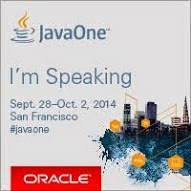There are some absolutely SUPERB conferences dedicated to Java (the language, the platform, the ecosystem) around the world, and I’ve been privileged to speak at some of them. No two are alike, and that is a good thing! JavaOne San Francisco holds a very special place in that lineup, bringing together a phenomenal mixture of vision, direction, community leadership, and grassroots innovation that is nearly impossible to describe. You just have to be there!
This year I’m pleased and honored to be presenting in three sessions, sharing the stage with some of my favorite people from around the world: Jim Weaver, Sean Phillips, David Heffelfinger, Geertjan Wielenga, Jens Deters, José Pereda, and James Gosling. As I said, it’s a genuine honor!
Here are the sessions in which I’ll be taking part:
Creating Our Robot Overlords: Autonomous Drone Development with Java and the Internet of Things [CON1863]
Tuesday, Sep 30, 2:30 PM – 3:30 PM – Hilton – Continental Ballroom 4
Who wants a mindless drone? Teach it to “think,” and it can do so much more. But how do you take it from Toy Story to Terminator? This session’s speakers discuss their new open source library, Autonomous4j, for autonomous drone development. Combining this library and some components from their mad science toolkit, they demonstrate how to get your Internet of Things off the ground and do some real cloud computing. In the session, you’ll learn how to write an autonomous drone program with Java 8; deploy it to the drone’s “positronic brain,” an onboard Raspberry Pi; have the Pi guide an AR.Drone to accomplish a task; monitor it via a JavaFX console; and create your own robot overlord. Demos are included: you’ve been warned!
With Jim Weaver & Sean Phillips
Debugging and Profiling Robots with James Gosling [CON6699]
Wednesday, Oct 1, 1:00 PM – 2:00 PM – Hilton – Continental Ballroom 4
James Gosling recently stated that “being able to debug and profile robots out at sea is a truly life-altering experience.” He uses a set of tools—consisting of editors, debuggers, and profilers—that are part of the NetBeans IDE. In this session, Gosling and other speakers introduce you to these tools and show you how easily and quickly you can program and interact with devices via Java tools. Come see how well integrated embedded devices are with the Java ecosystem.
With Geertjan Wielenga, Jens Deters, José Pereda, & James Gosling
Java Platform, Enterprise Edition Lab 101: An Introduction [HOL1827]
Wednesday, Oct 1, 10:00 AM – 12:00 PM – Hilton – Franciscan A/B
For anyone familiar with the Java language but without direct Java Platform, Enterprise Edition (Java EE) experience, the capabilities and APIs in Java EE can seem daunting. Documentation is helpful, and well-written books can make it easier to come up to speed, but isn’t the best way to learn something to actually do it? This session’s speakers hope to smooth the path for anyone curious about Java EE by offering a gentle, yet useful, introduction to four key concepts:
• JavaServer Faces (JSF)
• Contexts and Dependency Injection (CDI)
• Java Persistence API (JPA)
• Enterprise JavaBeans (EJB)
Using NetBeans and the bundled GlassFish application server, the speakers present each new concept with live code and then help attendees complete hands-on exercises.
With David Heffelfinger (and gracious assistance from Sven Reimers, Josh Juneau, Bob Larsen, & Bruno Borges)
I’ve said it before: There’s no better place to see what’s happening in the world of Java than JavaOne. Hope to see you there!
All the best,
Mark
Cross-posted from The Java Jungle.
Related Posts:
Tags: autonomous, drone, Embedded, hacking, hol, IoT, java, JavaEE, JavaFX, javaone, remote






